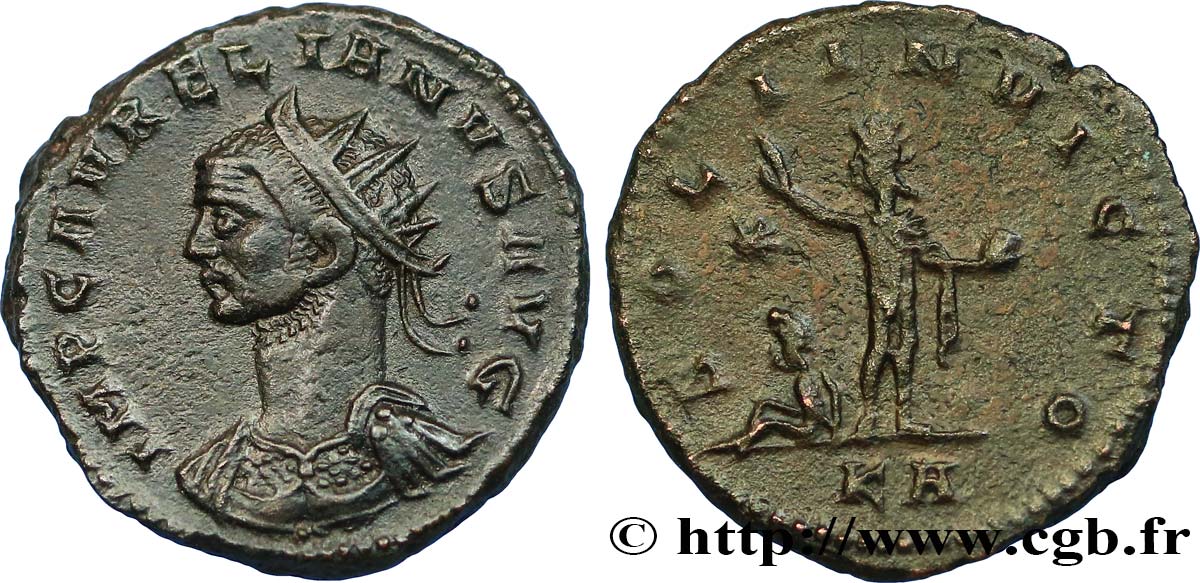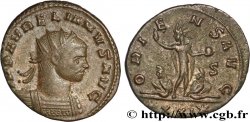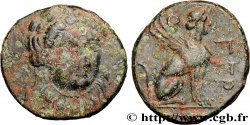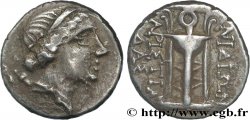brm_365428 - AURELIAN Aurelianus
380.00 €(Approx. 444.60$ | 330.60£)
Quantity
Add to your cart

Type : Aurelianus
Date: printemps
Date: 274
Mint name / Town : Tripolis
Metal : billon
Millesimal fineness : 50 ‰
Diameter : 22 mm
Orientation dies : 12 h.
Weight : 4,99 g.
Rarity : R2
Coments on the condition:
Exemplaire sur un flan ovale et épais, régulier et bien centré. Très beau portrait inhabituel. Frappe molle au revers avec une usure superficielle. Très jolie patine marron foncé, légèrement granuleuse au revers
Catalogue references :
Predigree :
Cet exemplaire provient de la vente Aufhaüser 12 du 1er octobre 1996, n° 719, de la vente E-auction CNG. 275, n° 160, de MONNAIES 59, N° 505 et de la collection Daniel Compas
Obverse
Obverse legend : IMP C AVRELIANVS AVG.
Obverse description : Buste radié et cuirassé d’Aurélien à gauche drapé sur l’épaule, vu de trois quarts en avant (B1).
Obverse translation : "Imperator Cæsar Aurelianus Augustus", (L'empereur césar Aurélien auguste).
Reverse
Reverse legend : SOL-I INVICTO/ *|-// KA.
Reverse description : Sol (Le Soleil) radié, nu, le manteau sur l’épaule gauche, debout à gauche, levant la main droite et tenant un globe de la gauche ; à ses pieds, à gauche, un captif assis, les mains liées dans le dos.
Reverse translation : “Soli Invicto”, (Au Soleil Invincible).
Commentary
Poids très lourd. Sans argenture superficielle. Buste exceptionnel. Rubans de type 3 aux extrémités bouletées. Égide posée sur la cuirasse. Grandes ptéryges fines et souples. Petit pan de paludamentum sur l’épaule gauche. Ce type semble beaucoup plus rare que ne le laissent supposer les ouvrages généraux. Sylviane Estiot (BN/RXII.1, op. cit., p. 438) ne signale que six exemplaires à Vienne avec ce type de buste et parfois avec un globule après INVICTO au revers).
Very heavy weight. Without surface silvering. Exceptional bust. Type 3 ribbons with pelleted ends. Aegis placed on the breastplate. Large, thin and flexible pteryga. Small flap of paludamentum on the left shoulder. This type seems much rarer than general works suggest. Sylviane Estiot (BN/RXII.1, op. cit., p. 438) only reports six examples in Vienna with this type of bust and sometimes with a globule after INVICTO on the reverse)
Very heavy weight. Without surface silvering. Exceptional bust. Type 3 ribbons with pelleted ends. Aegis placed on the breastplate. Large, thin and flexible pteryga. Small flap of paludamentum on the left shoulder. This type seems much rarer than general works suggest. Sylviane Estiot (BN/RXII.1, op. cit., p. 438) only reports six examples in Vienna with this type of bust and sometimes with a globule after INVICTO on the reverse)








 Report a mistake
Report a mistake Print the page
Print the page Share my selection
Share my selection Ask a question
Ask a question Consign / sell
Consign / sell
 Full data
Full data











